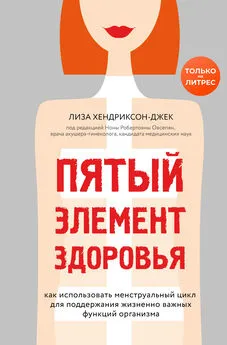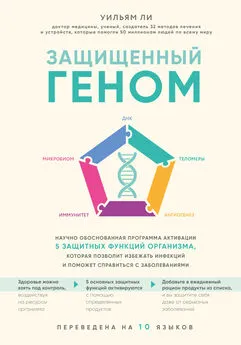Лиза Хендриксон-Джек - Пятый элемент здоровья. Как использовать менструальный цикл для поддержания жизненно важных функций организма
- Название:Пятый элемент здоровья. Как использовать менструальный цикл для поддержания жизненно важных функций организма
- Автор:
- Жанр:
- Издательство:Литагент 5 редакция
- Год:2020
- Город:Москва
- ISBN:978-5-04-104425-1
- Рейтинг:
- Избранное:Добавить в избранное
-
Отзывы:
-
Ваша оценка:
Лиза Хендриксон-Джек - Пятый элемент здоровья. Как использовать менструальный цикл для поддержания жизненно важных функций организма краткое содержание
«Почти» – потому что у женщин есть пятый показатель здоровья, на который, к сожалению, все еще мало кто обращает внимание, – это менструальный цикл. Короткий или длинный, регулярный или непредсказуемый – цикл может быть очень разным, и каждый его параметр, каждое изменение служат индикатором той или иной проблемы в организме. Планируете вы беременность или нет, овуляция имеет значение для поддержания здоровья.
Автор этой книги расскажет, что именно влияет на состояние менструального цикла, и научит вас составлять его график для максимально точного и удобного отслеживания различных изменений и контроля здоровья.
Пятый элемент здоровья. Как использовать менструальный цикл для поддержания жизненно важных функций организма - читать онлайн бесплатно ознакомительный отрывок
Интервал:
Закладка:
12. Maxwell, Christy, and Stella Lucia Volpe. “Effect of zinc supplementation on thyroid hormone function.” Annals of Nutrition and Metabolism 51, no. 2 (2007): 188–194.
13. Fallah, Soudabeh, Fatemeh Valinejad Sani, and Mohsen Firoozrai. “Effect of contraceptive pill on the selenium and zinc status of healthy subjects.” Contraception 80, no. 1 (2009): 40–43; Hunt, Janet R. “Bioavailability of iron, zinc, and other trace minerals from vegetarian diets.” The American Journal of Clinical Nutrition 78, no. 3 (2003): 633S–639S.
14. Gupta, C.P. “Role of iron (Fe) in body.” IOSR Journal of Applied Chemistry (IOSR-JAC) 7 (2014): 38–46.
15. Takamatsu, J., M. Majima, K. Miki, K. Kuma, and T. Mozai. “Serum ferritin as a marker of thyroid hormone action on peripheral tissues.” The Journal of Clinical Endocrinology and Metabolism 61, no. 4 (1985): 672–676.
16. Sachdeva, Ashuma, Veena Singh, Isha Malik, Prasanta Saha Roy, Himanshu Madaan, and Rajesh Nair. “Association between serum ferritin and thyroid hormone profile in hypothyroidism.” International Journal of Medical Science and Public Health 4, no. 6 (2015): 863–865; Kubota, K., J. Tamura, H. Kurabayashi, T. Shirakura, and I. Kobayashi. “Evaluation of increased serum ferritin levels in patients with hyperthyroidism.” The Clinical Investigator 72, no. 1 (1993): 26–29.
17. Hess, Sonja Y., Michael B. Zimmermann, Myrtha Arnold, Wolfgang Langhans, and Richard F. Hurrell. “Iron deficiency anemia reduces thyroid peroxidase activity in rats.” The Journal of Nutrition 132, no. 7 (2002): 1951–1955; Zimmermann, Michael B. “The influence of iron status on iodine utilization and thyroid function.” Annual Review of Nutrition 26 (2006): 367–389.
18. Martinez-Torres, C., L. Cubeddu, E. Dillmann, G.L. Brengelmann, I. Leets, M. Layrisse, D.G. Johnson, and C. Finch. “Effect of exposure to low temperature on normal and iron-deficient subjects.” The American Journal of Physiology 246, no. 3 (1984): R380–R383; Beard, John L., M.J. Borel, and Janice Derr. “Impaired thermoregulation and thyroid function in iron-deficiency anemia.” The American Journal of Clinical Nutrition 52, no. 5 (1990): 813–819.
19. Beard, John L., M.J. Borel, and Janice Derr. “Impaired thermoregulation and thyroid function in iron-deficiency anemia.” The American Journal of Clinical Nutrition 52, no. 5 (1990): 813–819.
20. Gröber, Uwe, Joachim Schmidt, and Klaus Kisters. “Magnesium in prevention and therapy.” Nutrients 7, no. 9 (2015): 8199–8226.
21. Mazur, Andrzej, Jeanette A.M. Maier, Edmond Rock, Elyett Gueux, Wojciech Nowacki, and Yves Rayssiguier. “Magnesium and the inflammatory response: potential physiopathological implications.” Archives of Biochemistry and Biophysics 458, no. 1 (2007): 48–56; Abbas, Amr M., and Hussein F. Sakr. “Effect of magnesium sulfate and thyroxine on inflammatory markers in a rat model of hypothyroidism.” Canadian Journal of Physiology and Pharmacology 94, no. 4 (2015): 426–432; Moncayo, Roy, and Helga Moncayo. “The WOMED model of benign thyroid disease: acquired magnesium deficiency due to physical and psychological stressors relates to dysfunction of oxidative phosphorylation.” BBA Clinical 3 (2015): 44–64.
22. Moncayo, Roy, and Helga Moncayo. “Proof of concept of the WOMED model of benign thyroid disease: restitution of thyroid morphology after correction of physical and psychological stressors and magnesium supplementation.” BBA Clinical 3 (2015): 113–122; Moncayo, Roy, and Helga Moncayo. “The WOMED model of benign thyroid disease: acquired magnesium deficiency due to physical and psychological stressors relates to dysfunction of oxidative phosphorylation.” BBA Clinical 3 (2015): 44–64; Baldini, Marina, Daniela Castagnone, Roberto Rivolta, Laura Meroni, Marco Pappalettera, and Luigi Cantalamessa. “Thyroid vascularization by color doppler ultrasonography in Graves’ disease. Changes related to different phases and to the long-term outcome of the disease.” Thyroid 7, no. 6 (1997): 823–828.
23. Moncayo, Roy, and Helga Moncayo. “The WOMED model of benign thyroid disease: acquired magnesium deficiency due to physical and psychological stressors relates to dysfunction of oxidative phosphorylation.” BBA Clinical 3 (2015): 44–64; Moncayo, Roy, and Helga Moncayo. “Proof of concept of the WOMED model of benign thyroid disease: restitution of thyroid morphology after correction of physical and psychological stressors and magnesium supplementation.” BBA Clinical 3 (2015): 113–122.
24. Hess, Sonja Y. “The impact of common micronutrient deficiencies on iodine and thyroid metabolism: the evidence from human studies.” Best Practice & Research Clinical Endocrinology & Metabolism 24, no. 1 (2010): 117–132; Oba, Kiyoshi, and Shuichi Kimura. “Effects of vitamin A deficiency on thyroid function and serum thyroxine levels in the rat.” Journal of Nutritional Science and Vitaminology 26, no. 4 (1980): 327–334; Zimmermann, M.B. “Interactions of vitamin A and iodine deficiencies: effects on the pituitary-thyroid axis.” International Journal for Vitamin and Nutrition Research 77, no. 3 (2007): 236–240; Farhangi, Mahdieh Abbasalizad, Seyyed Ali Keshavarz, Mohammadreza Eshraghian, Alireza Ostadrahimi, and Ali Akbar Saboor-Yaraghi. “The effect of vitamin A supplementation on thyroid function in premenopausal women.” Journal of the American College of Nutrition 31, no. 4 (2012): 268–274.
25. Sarandöl, Emre, Sibel Taş, Melahat Dirican, and Zehra Serdar. “Oxidative stress and serum paraoxonase activity in experimental hypothyroidism: effect of vitamin E supplementation.” Cell Biochemistry and Function 23, no. 1 (2005): 1–8; Padayatty, Sebastian J., Arie Katz, Yaohui Wang, Peter Eck, Oran Kwon, Je-Hyuk Lee, Shenglin Chen et al. “Vitamin C as an antioxidant: evaluation of its role in disease prevention.” Journal of the American College of Nutrition 22, no. 1 (2003): 18–35.
26. Kivity, Shaye, Nancy Agmon-Levin, Michael Zisappl, Yinon Shapira, Endre V. Nagy, Katalin Dankó, Zoltan Szekanecz, Pnina Langevitz, and Yehuda Shoenfeld. “Vitamin D and autoimmune thyroid diseases.” Cellular & Molecular Immunology 8, no. 3 (2011): 243; Yasuda, Tetsuyuki, Yasuyuki Okamoto, Noboru Hamada, Kazuyuki Miyashita, Mitsuyoshi Takahara, Fumie Sakamoto, Takeshi Miyatsuka et al. “Serum vitamin D levels are decreased and associated with thyroid volume in female patients with newly onset Graves’ disease.” Endocrine 42, no. 3 (2012): 739–741.
27. Wang, Yi-Ping, Hung-Pin Lin, Hsin-Ming Chen, Ying-Shiung Kuo, Ming-Jane Lang, and Andy Sun. “Hemoglobin, iron, and vitamin B 12deficiencies and high blood homocysteine levels in patients with anti-thyroid autoantibodies.” Journal of the Formosan Medical Association 113, no. 3 (2014): 155–160; Ness-Abramof, Rosane, Dan A. Nabriski, Menachem S. Shapiro, Louis Shenkman, Lotan Shilo, Eliahu Weiss, Tamar Reshef, and Lewis E. Braverman. “Prevalence and evaluation of B12 deficiency in patients with autoimmune thyroid disease.” The American Journal of the Medical Sciences 332, no. 3 (2006): 119–122.
28. Jabbar, Abdul, Aasma Yawar, Sabiha Waseem, Najmul Islam, Naeem Ul Haque, Lubna Zuberi, Ataullah Khan, and Jaweed Akhter. “Vitamin B12 deficiency common in primary hypothyroidism.” Journal of the Pakistan Medical Association 58, no. 5 (2008): 258.
29. Dakshinamurti, K., C.S. Paulose, J.A. Thliveris, and J. Vriend. “Thyroid function in pyridoxine-deficient young rats.” Journal of Endocrinology 104, no. 3 (1985): 339–344.
30. Chandrasekhar, K., Jyoti Kapoor, and Sridhar Anishetty. “A prospective, randomized double-blind, placebo-controlled study of safety and efficacy of a high-concentration full-spectrum extract of ashwagandha root in reducing stress and anxiety in adults.” Indian Journal of Psychological Medicine 34, no. 3 (2012): 255–262.
31. Sharma, Ashok Kumar, Indraneel Basu, and Siddarth Singh. “Efficacy and safety of ashwagandha root extract in subclinical hypothyroid patients: a double-blind, randomized placebo-controlled trial.” The Journal of Alternative and Complementary Medicine 24, no. 3 (2018): 243–248.
32. Clements Jr., Rex S., and Betty Darnell. “Myo-inositol content of common foods: development of a high-myo-inositol diet.” The American Journal of Clinical Nutrition 33, no. 9 (1980): 1954–1967; Williams, Peter. “The missing vitamin alphabet.” Nutrition & Dietetics 73, no. 2 (2016): 205–214.
33. Ferrari, S.M., P. Fallahi, F. Di Bari, R. Vita, S. Benvenga, and A. Antonelli. “Myo-inositol and selenium reduce the risk of developing overt hypothyroidism in patients with autoimmune thyroiditis.” European Review for Medical and Pharmacological Sciences 21, no. 2 supplement (2017): 36–42; Nordio, Maurizio, and Raffaella Pajalich. “Combined treatment with myo-inositol and selenium ensures euthyroidism in subclinical hypothyroidism patients with autoimmune thyroiditis.” Journal of Thyroid Research (2013): 1–5; Nordio, M., and S. Basciani. “Myo-inositol plus selenium supplementation restores euthyroid state in Hashimoto’s patients with subclinical hypothyroidism.” European Review for Medical and Pharmacological Sciences 21, no. 2 Suppl (2017): 51–59.
34. Nestler, John E., Daniela J. Jakubowicz, William S. Evans, and Renato Pasquali. “Effects of metformin on spontaneous and clomiphene-induced ovulation in the polycystic ovary syndrome.” New England Journal of Medicine 338, no. 26 (1998): 1876–1880.
35. Siavash, Mansour, Majid Tabbakhian, Ali Mohammad Sabzghabaee, and Niloufar Razavi. “Severity of gastrointestinal side effects of metformin tablet compared to metformin capsule in type 2 diabetes mellitus patients.” Journal of Research in Pharmacy Practice 6, no. 2 (2017): 73–76.
36. Gower, Barbara A., Paula C. Chandler-Laney, Fernando Ovalle, Laura Lee Goree, Ricardo Azziz, Renee A. Desmond, Wesley M. Granger, Amy M. Goss, and G. Wright Bates. “Favourable metabolic effects of a eucaloric lower– carbohydrate diet in women with PCOS.” Clinical Endocrinology 79, no. 4 (2013): 550–557.
37. Nichols, Lily. (2018). Real Food for Pregnancy: The Science and Wisdom of Optimal Prenatal Nutrition. Lily Nichols, 141.
38. Westman, Eric C., William S. Yancy Jr., Mark D. Haub, and Jeff S. Volek. “Insulin resistance from a low carbohydrate, high fat diet perspective.” Metabolic Syndrome and Related Disorders 3, no. 1 (2005): 14–18.
39. Atkinson, Fiona S., Kaye Foster-Powell, and Jennie C. Brand-Miller. “International tables of glycemic index and glycemic load values: 2008.” Diabetes Care 31, no. 12 (2008): 2281–2283.
40. Gower, Barbara A., and Amy M. Goss. “A lower-carbohydrate, higher-fat diet reduces abdominal and intermuscular fat and increases insulin sensitivity in adults at risk of type 2 diabetes.” The Journal of Nutrition 145, no. 1 (2014): 177S–183S; McGrice, Melanie, and Judi Porter. “The effect of low carbohydrate diets on fertility hormones and outcomes in overweight and obese women: a systematic review.” Nutrients 9, no. 3 (2017): 1–11.
41. Mavropoulos, John C., William S. Yancy, Juanita Hepburn, and Eric C. Westman. “The effects of a low-carbohydrate, ketogenic diet on the polycystic ovary syndrome: a pilot study.” Nutrition & Metabolism 2, no. 1 (2005): 1–5.
42. Gower, Barbara A., Paula C. Chandler-Laney, Fernando Ovalle, Laura Lee Goree, Ricardo Azziz, Renee A. Desmond, Wesley M. Granger, Amy M. Goss, and G. Wright Bates. “Favourable metabolic effects of a eucaloric lower– carbohydrate diet in women with PCOS.” Clinical Endocrinology 79, no. 4 (2013): 550–557.
43. Thomson, Rebecca L., Simon Spedding, and Jonathan D. Buckley. “Vitamin D in the aetiology and management of polycystic ovary syndrome.” Clinical Endocrinology 77, no. 3 (2012): 343–350; Vieth, Reinhold. “Why the optimal requirement for Vitamin D3 is probably much higher than what is officially recommended for adults.” The Journal of Steroid Biochemistry and Molecular Biology 89 (2004): 575–579; Holick, Michael F. “Vitamin D deficiency.” New England Journal of Medicine 357, no. 3 (2007): 266–281; Souberbielle, Jean-Claude, Jean-Jacques Body, Joan M. Lappe, Mario Plebani, Yehuda Shoenfeld, Thomas J. Wang, Heike A. Bischoff-Ferrari et al. “Vitamin D and musculoskeletal health, cardiovascular disease, autoimmunity and cancer: recommendations for clinical practice.” Autoimmunity Reviews 9, no. 11 (2010): 709–715.
Читать дальшеИнтервал:
Закладка:









